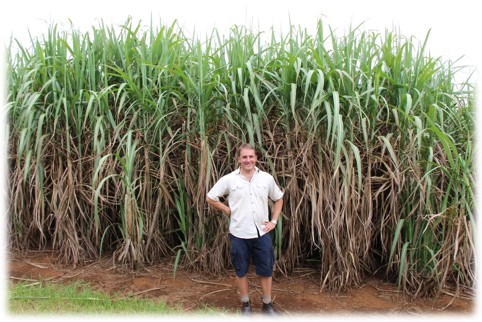In South Africa’s Midlands South region, a collaboration between a sugarcane farmer and the SASRI ripening- and regional Extension Specialist is paying dividends. Over the past decade, this farmer has worked alongside the two SASRI specialists in what is known as Participatory Research (PR), a hands-on approach where farming practices are tested directly in the field. This partnership has led to significant improvements in sugarcane quality and has provided valuable insights into the benefits of chemical ripening under Midlands growing conditions.
Starting in 2014, two long-term demonstration trials were established on commercial sugarcane fields of varieties N41 and N48 on the farm of Brad O’Neill in the Midlands South by SASRI’s Riekert van Heerden and Paul Botha. These trials were designed to compare the effects of chemical ripening against a treatment where no ripener was applied. The process involved spraying crops with a ripening chemical containing the active ingredient fluazifop-p-butyl, which helps to increase the Recoverable Value (RV) content of the cane.

Brad O’Neill on his farm in the Midlands South.
Over multiple 24-month crop cycles (plant and 4 ratoon crops), the trials consistently demonstrated that ripened sugarcane produced higher-quality cane with better RV content and RV yield, even though the cane yield slightly decreased. The increase in RV yield translated into better financial returns for Brad. For example, in some years, the RV yield increased by as much as 3.25 tons per hectare compared to the untreated cane with a benefit to cost ratio as high as 28.8.
The results from these demonstration trials had an impact on cane quality at individual farm level. Brad has gained confidence in using chemical ripening as part of his crop management strategy. Initially uncertain about the financial benefits of ripening, Brad now implements a targeted approach, ripening certain portions of his crop based on factors such as summer rainfall and variety.
This targeted use of ripening has paid off for Brad. By focusing on the early part of the harvest season, Brad has been able to deliver cane with significantly higher RV content than the average for his mill. Over the period 2018 to 2023, his farm consistently outperformed the mill average by up to 3.10 RV percentage points during April, when cane quality is typically low.
The success of these trials has not only benefited Brad but has also led to wider adoption of chemical ripening practices across the Midlands South region. As more farmers saw the positive results from the PR trials through targeted knowledge exchange (e.g., extension newsletters and grower days), the area of sugarcane being ripened with fluazifop-p-butyl in the Midlands South expanded significantly. By 2021, over 4 500 hectares were being treated, a substantial increase from the 648 hectares in 2018.
However, the adoption journey has not been without challenges. External factors, such as the recent unplanned carry-over cane dilemma, have impacted the consistency of adoption. Yet, the ongoing collaboration between farmers and SASRI researchers and extension specialists has ensured that these challenges are addressed, and that cane quality management practices are aligned accordingly.
Farmer-driven research in our industry has shown that collaboration between farmers and SASRI researchers and extension specialists can lead to practical, profitable outcomes. The insights gained from these trials have not only improved sugarcane quality on individual farms but have also driven broader adoption of best practices across the region. As the sugarcane industry faces ongoing challenges, the lessons learned from this participatory research will continue to play a crucial role in ensuring its future success.

The economic analyses of ripener results obtained in crops harvested between 2020 and 2024 in two participatory demonstration trial fields.

